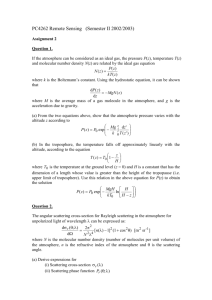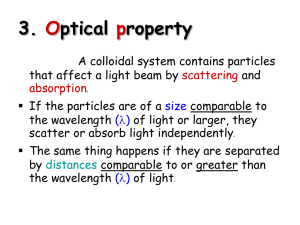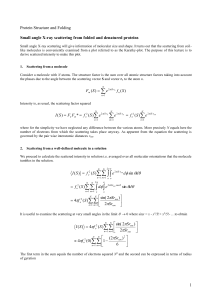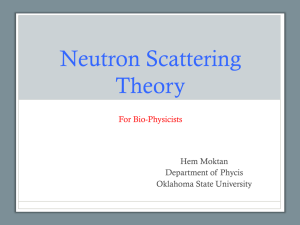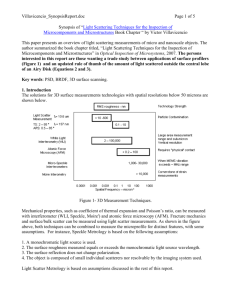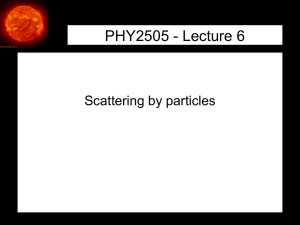LS part2 SLS
advertisement
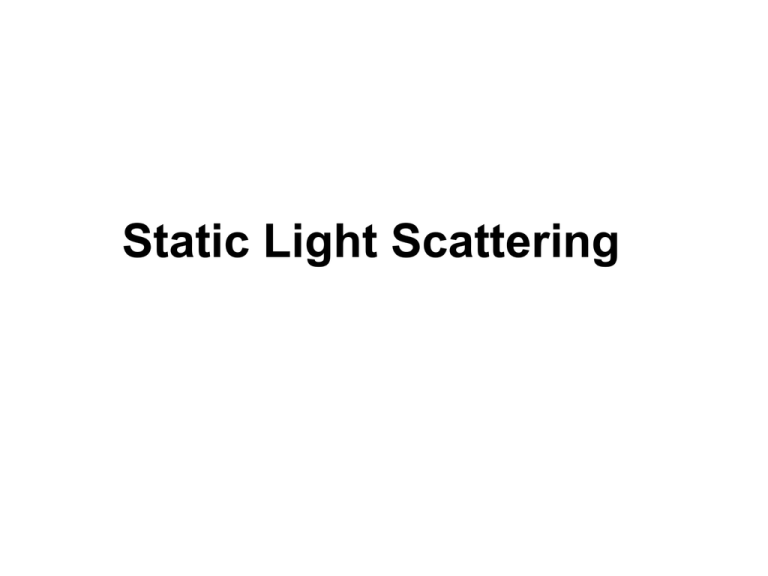
Static Light Scattering Outline of Static Light Scattering Measurement system Rayleigh scattering Static structure factor Form factors Practical problems Light Scattering Measurement System Scattering Wavevector top view wavevector 2 ki ks (in vacuum) 2 /n (in solution) scattering wavevector k k 4 n sin 2 Lengths Probed by Light Scattering ~ 33 nm ~ 100 nm Light scattering probes the length of ~1/k. Scattering Volume depends on the focusing of the laser. specified by the two pinholes. The scattering volume is an open system. Rayleigh Scattering by a Small Particle Why is the sky blue? Why is the sunset reddish? The particle is now a broadcasting station, emanating radiation in all directions. Polarization in the particle changes in phase with the incoming light. Rayleigh Scattering I I0 2 2 sin 2 4 0 2 r 2 Rayleigh scattering by a particle in vacuum : polarizability of the particle particle volume I maximizes at ´ = 90°. Usually, LS is detected in the horizontal plane. Scattering by a Chain Molecule (in Vacuum) I I0 2 2 1 0 r 4 2 2 N exp[ i k (ri r j )] i, j1 The beams scattered by the two particles interfere. Two parts of a large molecule interfere more or less constructively. Therefore, a large molecule scatters the light more strongly than many small particles do. Static Structure Factors suspension of small particles S (k ) nP 1 nP exp[ i k (ri r j )] n P exp[ i k ( ri r j )] i, j 1 single large molecule S1 (k ) 1 N N exp[ ik (ri r j )] i, j1 many large molecules S (k ) nP 1 nP N N exp[ ik (r mi r nj )] m, n 1 i , j 1 S1( k ) nP N N i, j 1 exp[ ik (r1i r2 j )] Structure Factor of a Polymer Chain radius of gyration high-angle scattering Rg low-angle scattering I 1 1 k 2 Rg 2 / 3 Form Factors Angular dependence of P(k) allows us to determine the shape of the molecule. P(k ) I( k ) I(0 ) Form Factor of a Sphere Rayleigh-Gans formula 2 Psp here ( k) 1 Vsp 2 Vsp Vsp dr Psp here ( x ) [3x d r exp[ i k (r r )] 3 (sin x x cos x )] 2 1 Vsp Vsp dr exp( ik r) with x kR EXCEL problems 1. Plot P as a function of kR. 2. Plot P as a function of for R = 10, 30, 100, 300, and 1000 nm. Assume specific values of n and . Light Scattering of a Solution I I0 ex 2 2 1 ( / n) ( 0 n ) r 4 2 2 2 2 4 ex 2 1 0 2 r 90 2 The formula derived for a molecule in vacuum can be used just by replacing with ex. ex molecule solvent A more convenient expression I ex I0 2 1 2 n dn c V 2 2 N A dc r 2 ex dn cV 2 n 0 dc N A 2 Light Scattering of Polymer Solutions I ex ( k ) I0 2 1 2 n d n cV P( k ) 2 2 NA dc r • Measure I(k) for pure solvent. • Measure I(k) for solutions of a given polymer at different concentrations. • Calculate Iex(k). Zimm Plot 2 1 2 n d n cV 1 P( k ) 2 A 2 c 2 2 NA dc r M I ex ( k ) I0 I ex I0 R V r2 2 1 2 n d n H N A 2 dc 2 2 1 P(k ) 1 k Rg / 3 1 Example of Zimm Plot Polyguanidine in THF Differential Refractive Index n n solution nsolvent At low concentrations, n dn c dc Often, we can approximate dn/dc as dn dc ( npolymer n solvent )v sp Concentration Effect on Scattering Intensity scattering at low concentrations I ex ( k ) I0 2 1 2 n d n cMV P( k ) 1 2 A 2 Mc 2 2 NA dc r Scattering by a Suspension of Spheres mass/volume I( kR ) I(0 )P (kR ) I( 0) cM M c 2 NA NA number/volume At constant c, I( 0) M Vsp R At constant , 2 I( 0) M M Vsp 2 3 3 R I( kR ) R P( kR ) 6 6 I( kR ) R P (kR ) Scattering by Spheres at Constant c At constant c, I( 0) M Vsp R 3 3 I( kR ) R P( kR ) EXCEL problems Plot R3P(kR) as a function of for R = 10, 30, 100, 300, and 1000 nm. Assume specific values of n and . Scattering by Spheres at Constant At constant , I( 0) M 2 Vsp 2 R 6 6 I( kR ) R P (kR ) EXCEL problems Plot R6P(kR) as a function of for R = 10, 30, 100, 300, and 1000 nm. Assume specific values of n and . Changes in the Scattering Intensity Spheres aggregate into larger spheres: 3 I2 R2 P(kR 2 ) I1 R1 P (kR1 ) Nonporous spheres become porous without changing the mass: 6 R 2 P( kR2 ) R1 P(kR1 ) I1 I2 Porous spheres become nonporous without changing R: (n porous spheres form 1 nonporous sphere) I nonp orous I porous 1 n n 2 n

